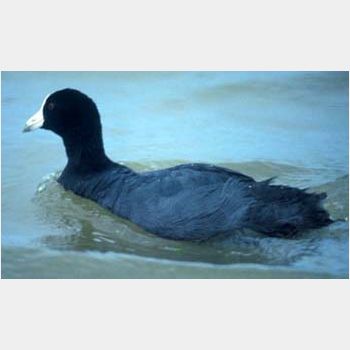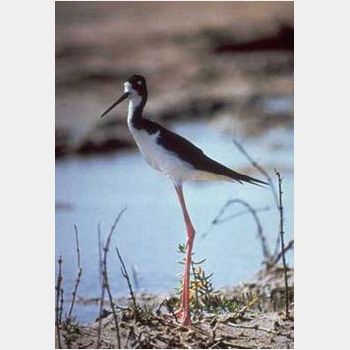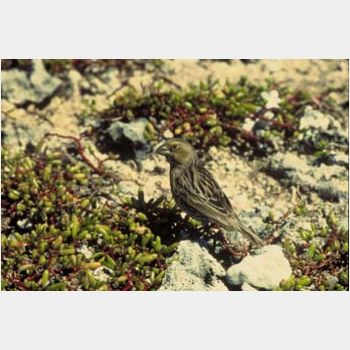Hawaii
Species and Description
(click for a detailed technical account) |
Trend
(click to view literature citations and larger graph) |
States
(current and historic range)
|
Laysan duck
Anas laysanensis
 By the late 19th century the Laysan duck had been extirpated from most of the Hawaiian islands, probably due to exotic predators such as rats. As of 1999, 211 birds descended from 19 founders existed in 32 facilities worldwide, and reintroductions have occurred on numerous islands. By the late 19th century the Laysan duck had been extirpated from most of the Hawaiian islands, probably due to exotic predators such as rats. As of 1999, 211 birds descended from 19 founders existed in 32 facilities worldwide, and reintroductions have occurred on numerous islands.
|
|
HI(b) --- |
Hawaiian goose
Branta sandvicensis
 Once numbering over twenty thousand birds, the Hawaiian goose (or “nene”) was reduced to 30 individuals by 1918 due to overzealous hunting, habitat loss, and introduced predators. As a result of captive breeding, reintroductions, predator control and habitat protection, it increased from 400 birds in 1980 to 1,275 in 2003. Once numbering over twenty thousand birds, the Hawaiian goose (or “nene”) was reduced to 30 individuals by 1918 due to overzealous hunting, habitat loss, and introduced predators. As a result of captive breeding, reintroductions, predator control and habitat protection, it increased from 400 birds in 1980 to 1,275 in 2003.
|
 |
HI(b) --- |
Hawaiian duck (koloa maoli)
Anas wyvilliana By 1949 the Hawaiian duck had declined and been extirpated from much of the Hawaiian islands due to hunting and exotic predators, as well as hybridization with domestic ducks. The most recent estimate is of 2,000 birds on Kauai, 200 on Hawaii and unknown numbers on Oahu and Maui. By 1949 the Hawaiian duck had declined and been extirpated from much of the Hawaiian islands due to hunting and exotic predators, as well as hybridization with domestic ducks. The most recent estimate is of 2,000 birds on Kauai, 200 on Hawaii and unknown numbers on Oahu and Maui.
|
 |
HI(b) --- |
Fin whale
Balaenoptera physalus Fin whales were hunted in all the world's oceans for the first three-quarters of the 20th century. There have been increases in both the North Atlantic and North Pacific populations in recent years. Fin whales were hunted in all the world's oceans for the first three-quarters of the 20th century. There have been increases in both the North Atlantic and North Pacific populations in recent years.
|
 |
AL(o), AK(s), CA(s), CT(s), DE(s), FL(s), GA(s), HI(s), LA(o), ME(s), MD(s), MA(s), MS(o), NH(s), NY(s), NJ(s), NC(s), OR(s), PA(s), RI(s), SC(s), TX(o), VA(s), WA(s) --- |
Hawaiian common moorhen (`alae `ula)
Gallinula chloropus sandvicensis Loss of wetland habitats led to a decline in Hawaiian common moorhen numbers. The population increased from 57 in the 1950's to 750 in 1985 and since then counts indicate an increasing population trend. Loss of wetland habitats led to a decline in Hawaiian common moorhen numbers. The population increased from 57 in the 1950's to 750 in 1985 and since then counts indicate an increasing population trend.
|
 |
HI(b) --- |
Blue whale
Balaenoptera musculus The blue whale was reduced by as much as 99% due to whaling that occurred until the mid-1960's. The number of whales reported off the coast of California increased from 704 in 1980 to an estimated 1,744 today. The blue whale was reduced by as much as 99% due to whaling that occurred until the mid-1960's. The number of whales reported off the coast of California increased from 704 in 1980 to an estimated 1,744 today.
|
 |
AK(s), CA(s), FL(o), HI(s), ME(o), MD(o), MA(o), NI(o), NH(o), NY(o), NC(o), OR(o), PR(o), RI(o), SC(o), VI(o), WA(o) --- |
Pacific green sea turtle
Chelonia mydas agassizii The green sea turtle occurs throughout the tropical and subtropical waters of the Mediterranean, Atlantic, Pacific, and Indian Oceans, but declined due to hunting and habitat loss to development. In Hawaii, greater than 90% of nesting occurs at French Frigate Shoals, and nesting females increased there from 75 in 1973 to 470 in 2003 The green sea turtle occurs throughout the tropical and subtropical waters of the Mediterranean, Atlantic, Pacific, and Indian Oceans, but declined due to hunting and habitat loss to development. In Hawaii, greater than 90% of nesting occurs at French Frigate Shoals, and nesting females increased there from 75 in 1973 to 470 in 2003
|
 |
AS(b), CA(s), GU(b), HI(b), MP(b), OR(o), WA(o) --- |
Hawaiian coot (`alae ke`oke`o)
Fulica alai The Hawaiian coot was initially threatened by hunting in the first half of the last century, but is now threatened primarily by loss of habitat. The Hawaiian coot has increased from 1,000 birds on an extinction trajectory in the 1960's to over 2,000 birds today. The Hawaiian coot was initially threatened by hunting in the first half of the last century, but is now threatened primarily by loss of habitat. The Hawaiian coot has increased from 1,000 birds on an extinction trajectory in the 1960's to over 2,000 birds today.
|
 |
HI(b) --- |
Palila
Loxioides bailleui By the 1940s it was considered endangered because of its extirpation from Mauna Loa, Haulalai, and the mid elevations of Mauna Kea due to avian disease, predation by cats and rats, fire, and ungulate grazing. Populations on the southwestern slope of Mauna Kea have been slowly increasing following the removal of feral sheep. By the 1940s it was considered endangered because of its extirpation from Mauna Loa, Haulalai, and the mid elevations of Mauna Kea due to avian disease, predation by cats and rats, fire, and ungulate grazing. Populations on the southwestern slope of Mauna Kea have been slowly increasing following the removal of feral sheep.
|
 |
HI(b) --- |
Hawaiian stilt (ae`o)
Himantopus mexicanus knudseni The Hawaiian stilt declined to 200 birds by 1941 due to habitat loss, predation, and hunting. The total population is currently between 1,500 to 1,800 birds. The Hawaiian stilt declined to 200 birds by 1941 due to habitat loss, predation, and hunting. The total population is currently between 1,500 to 1,800 birds.
|
 |
HI(b) --- |
Humpback whale
Megaptera novaeangliae Humpback whale populations were greatly depleted by commercial whaling by the early 1900's. In 1966, the entire North Pacific humpback population was thought to number only around 1,200 animals; this estimate increased to between 6,000 and 8,000 by 1992. Humpback whale populations were greatly depleted by commercial whaling by the early 1900's. In 1966, the entire North Pacific humpback population was thought to number only around 1,200 animals; this estimate increased to between 6,000 and 8,000 by 1992.
|
 |
AL(o), AK(s), CA(s), CT(s), DE(s), FL(s), GA(s), HI(s), LA(o), ME(s), MD(s), MA(s), MS(o), NI(s), NH(s), NY(s), NJ(s), NC(s), OR(s), PR(o), RI(s), SC(s), TX(o), VI(s), VA(s), WA(s) --- |
Laysan finch
Telespiza cantans The Laysan finch is endemic to Laysan Island, Hawaii. Populations have fluctuated since being listed in 1967, but appear to be slowly increasing; in addition, a small population of finches were introduced four islets of Pearl and Hermes Atolls. The Laysan finch is endemic to Laysan Island, Hawaii. Populations have fluctuated since being listed in 1967, but appear to be slowly increasing; in addition, a small population of finches were introduced four islets of Pearl and Hermes Atolls.
|
 |
HI(b) --- |
|
|
(b) currently breeds, (s) seasonally present, (m) migration route, (o) occasionally present, (x) extirpated
|
 |















PhillipColla.jpg)












